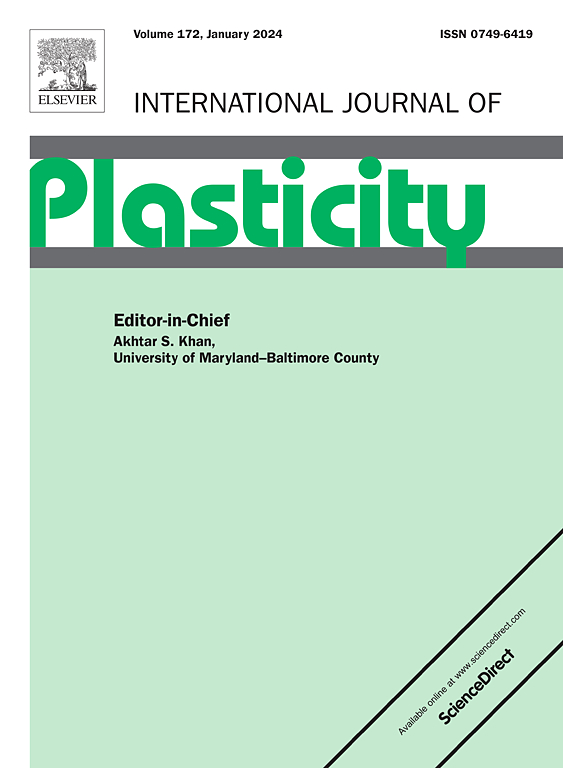Instability of Omega phase induces synchronously improved strength and plasticity of metastable β-titanium alloys
IF 9.4
1区 材料科学
Q1 ENGINEERING, MECHANICAL
引用次数: 0
Abstract
Metastable β-Titanium alloys combine excellent work-hardenability and good plasticity due to phase transformation induced plasticity (TRIP) and/or twinning induced plasticity (TWIP) effects, but exhibit poor yield strength. While isothermal ω-phase (ωiso) precipitation effectively strengthens these alloys, it typically compromises their plasticity. This study develops a strategy to harness ω-phase precipitation for simultaneously enhancing tensile strength and maintaining plasticity in metastable β titanium alloys. Experimental results reveal that ω-phase particles significantly improve yield strength while initiating localized necking through dislocation channel formation. This necking facilitates the rapid multiplication of dislocations in the strain-localization area, leading to forest dislocation hardening. Additionally, there is extra work hardening due to the interaction of dislocations with stress-induced twins and α'' martensites. This dual work-hardening mechanism restrains and stabilizes premature necking. Continuous interactions between ω-phase particles and lattice defects (dislocations, twins, α" martensites), coupled with subsequent hardening from dislocation-defect interplay, induce two distinct necking events prior to final fracture. Each necking stage triggers corresponding hardening responses that progressively regulate deformation behavior. Consequently, an exceptional strength-ductility synergy is achieved, resulting in a 680 MPa yield strength and 51.77 % elongation after 150 °C aging. This work provides an instability-control strategy that coordinates forest hardening with dislocation-twin/α" martensites interaction hardening, thereby synchronously improving strength and plasticity (SISP) of metastable β titanium alloys.


ω相的不稳定性导致亚稳β-钛合金的强度和塑性同步提高
亚稳态β-钛合金由于相变诱导塑性(TRIP)和/或孪晶诱导塑性(TWIP)的作用,具有良好的加工淬透性和塑性,但屈服强度较差。虽然等温ω相(ωiso)析出有效地增强了这些合金,但它通常会损害它们的塑性。本研究开发了一种利用ω相析出同时提高亚稳β钛合金抗拉强度和保持塑性的策略。实验结果表明,ω相颗粒通过位错通道的形成引发局部颈缩,显著提高了屈服强度。这种缩颈有利于位错在应变局部化区域的快速增殖,导致森林位错硬化。此外,由于位错与应力诱导孪晶和α”马氏体的相互作用,还存在额外的加工硬化。这种双重加工硬化机制抑制和稳定了过早的颈缩。ω相颗粒和晶格缺陷(位错、孪晶、α”马氏体)之间的连续相互作用,加上位错-缺陷相互作用导致的后续硬化,在最终断裂之前诱发了两次明显的颈缩事件。每个颈缩阶段触发相应的硬化反应,逐渐调节变形行为。因此,实现了卓越的强度-塑性协同作用,在150°C时效后获得680 MPa的屈服强度和51.77%的伸长率。这项工作提供了一种不稳定控制策略,协调森林硬化与位错-孪晶/α”马氏体相互作用硬化,从而同步提高亚稳β钛合金的强度和塑性(SISP)。
本文章由计算机程序翻译,如有差异,请以英文原文为准。
求助全文
约1分钟内获得全文
求助全文
来源期刊

International Journal of Plasticity
工程技术-材料科学:综合
CiteScore
15.30
自引率
26.50%
发文量
256
审稿时长
46 days
期刊介绍:
International Journal of Plasticity aims to present original research encompassing all facets of plastic deformation, damage, and fracture behavior in both isotropic and anisotropic solids. This includes exploring the thermodynamics of plasticity and fracture, continuum theory, and macroscopic as well as microscopic phenomena.
Topics of interest span the plastic behavior of single crystals and polycrystalline metals, ceramics, rocks, soils, composites, nanocrystalline and microelectronics materials, shape memory alloys, ferroelectric ceramics, thin films, and polymers. Additionally, the journal covers plasticity aspects of failure and fracture mechanics. Contributions involving significant experimental, numerical, or theoretical advancements that enhance the understanding of the plastic behavior of solids are particularly valued. Papers addressing the modeling of finite nonlinear elastic deformation, bearing similarities to the modeling of plastic deformation, are also welcomed.
 求助内容:
求助内容: 应助结果提醒方式:
应助结果提醒方式:


